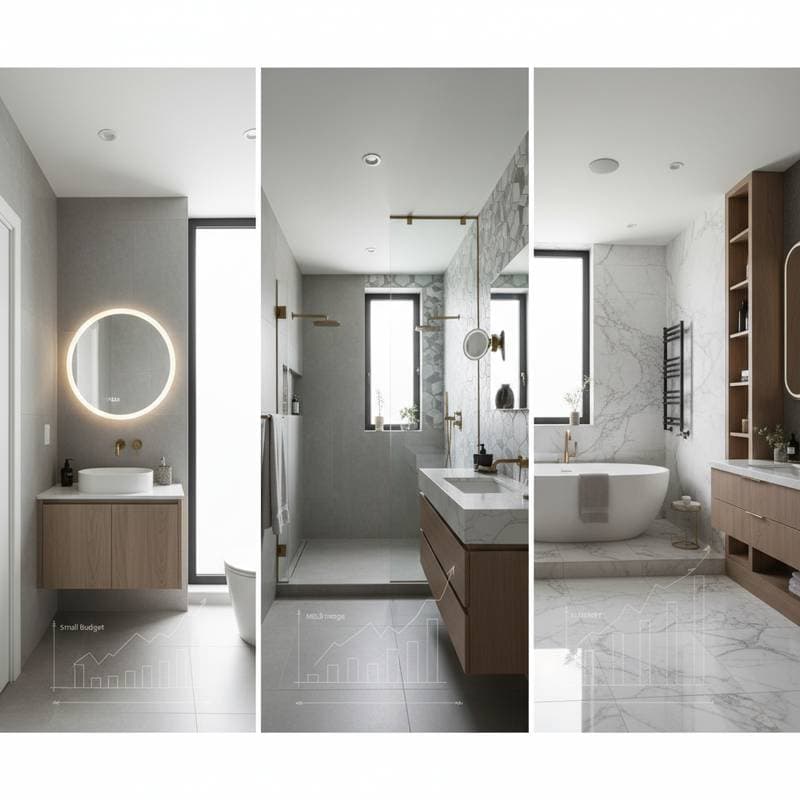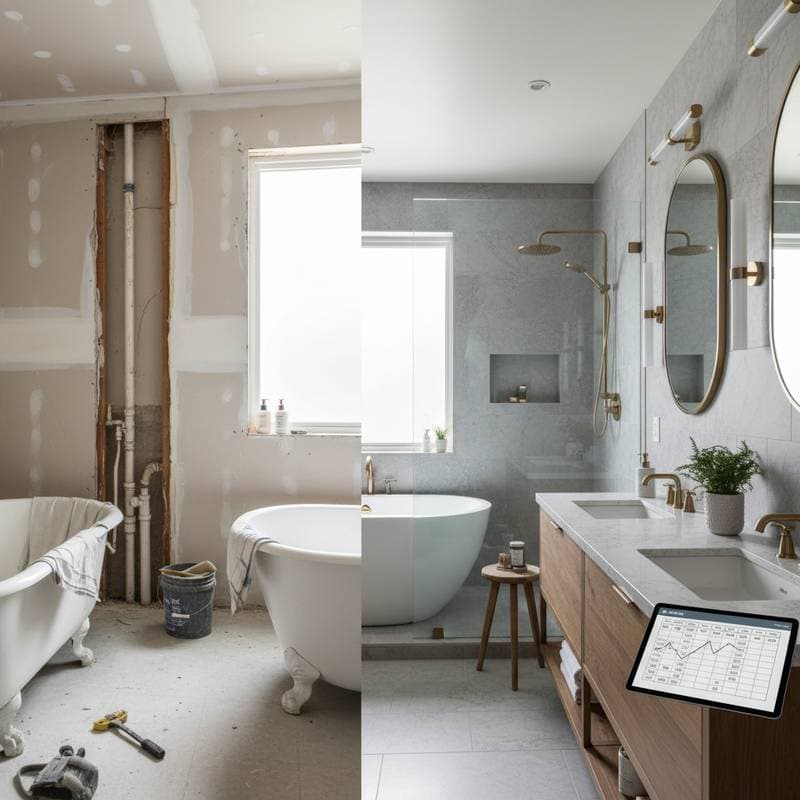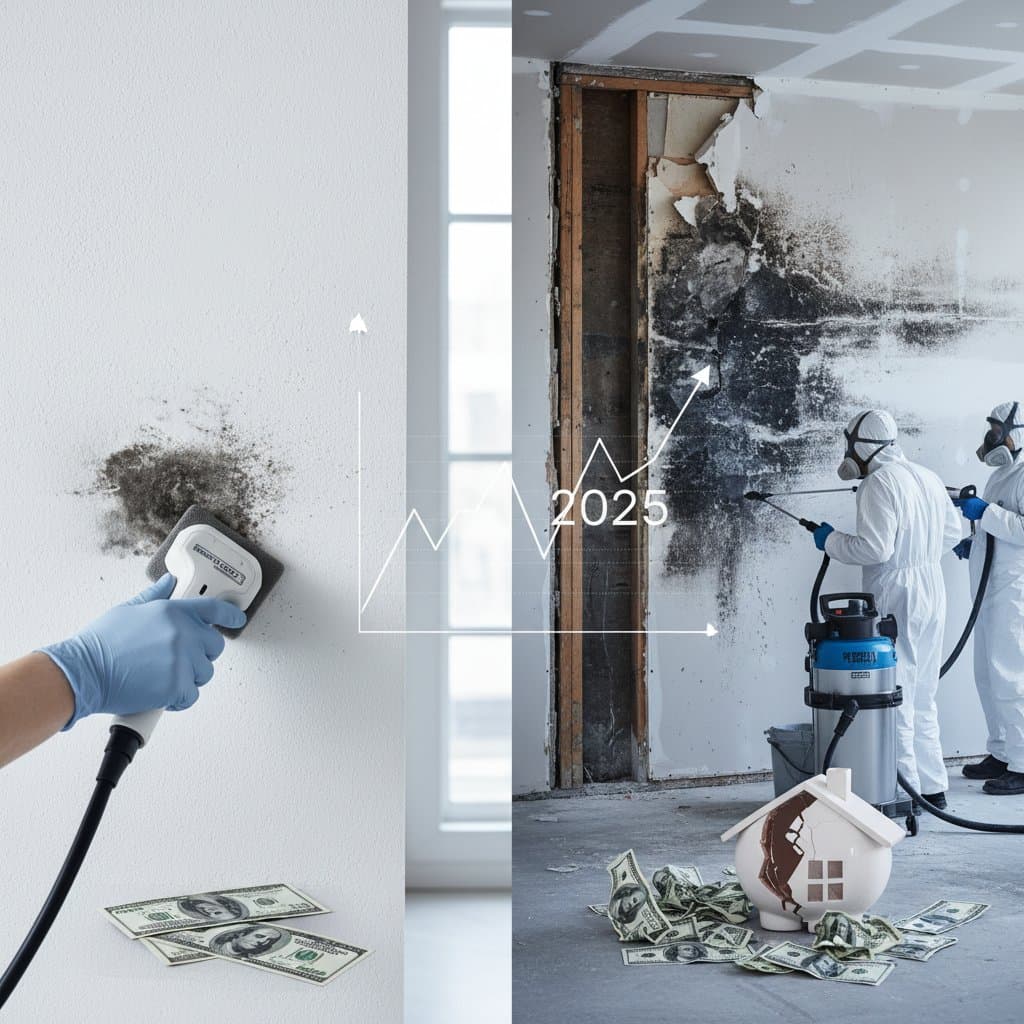Bathroom Remodel Costs in 2025: Maximizing ROI and Budgeting Wisely
A bathroom remodel transforms daily routines into experiences of comfort and style while enhancing overall home value. Homeowners face decisions about scope, from minor refreshes to comprehensive overhauls, each with distinct financial implications. This guide provides detailed insights into costs, return on investment, and budgeting strategies to ensure informed choices that deliver lasting benefits.
Understanding Bathroom Remodel Costs
Bathroom remodeling expenses fluctuate based on scope, location, and selections. A modest refresh that retains the original footprint demands fewer resources than an expansive project involving layout changes or added amenities.
Typical cost ranges for 2025:
- Small or partial remodel: $3,000 to $7,000, covering updates like new fixtures and paint.
- Mid-range remodel: $10,000 to $25,000, including vanity replacements and tile work.
- Luxury remodel: $30,000 and above, featuring custom elements and high-end materials.
Key cost factors:
- Bathroom size: Larger areas demand more square footage of materials and extended labor time.
- Material selections: Options such as porcelain tile at $5 to $15 per square foot or quartz countertops at $50 to $100 per square foot influence totals significantly.
- Plumbing and electrical modifications: Relocating lines or outlets can add $1,000 to $5,000 due to specialized skills required.
- Labor charges: Professionals bill $50 to $150 per hour, varying by region and expertise.
- Finishing elements: Custom vanities starting at $500 or designer lighting at $200 per fixture elevate expenses.
Homeowners tackling minor tasks, such as hardware swaps or wall painting, benefit from a do-it-yourself method to reduce outlays. However, intricate work like installing waterproof membranes or adjusting plumbing demands certified experts to prevent future repairs that could exceed initial savings.
ROI and Value of a Bathroom Remodel
An effective bathroom renovation yields substantial returns through enhanced usability and market desirability. Updated spaces appeal to prospective buyers, who prioritize modern sanitation and aesthetics in property evaluations.
Average ROI estimates:
- Minor remodels: Recover 70 to 85 percent of costs, particularly in competitive housing markets.
- Major remodels: Recoup 50 to 65 percent, with higher rates in upscale neighborhoods where quality finishes command premiums.
To optimize returns, emphasize practical enhancements over opulent additions. Install low-flow toilets that save water and reduce utility bills, or incorporate frameless glass enclosures paired with neutral-toned tiles for a spa-like atmosphere that broadens buyer interest.
Budget Planning and Cost Management
Establish a comprehensive budget at the outset, allocating 10 to 20 percent for unforeseen issues like mold remediation or structural reinforcements. Such preparations mitigate financial strain during execution.
Effective budgeting strategies:
- Focus on core components: Address plumbing integrity, adequate ventilation, and moisture barriers before aesthetic choices.
- Solicit multiple bids: Obtain itemized proposals from at least three contractors to identify competitive rates.
- Repurpose existing items: Refinish a serviceable bathtub for $300 to $500 instead of full replacement at $2,000.
- Select durable mid-tier materials: Choose ceramic tiles at $8 per square foot for resilience without premium pricing.
- Develop a realistic schedule: Coordinate material deliveries to avoid idle labor days that inflate costs.
| Category | Low-End Cost | Mid-Range Cost | High-End Cost |
|---|---|---|---|
| Fixtures (sink, toilet, shower) | $800 | $2,500 | $6,000 |
| Materials (tile, countertop) | $1,000 | $3,000 | $8,000 |
| Labor (demolition to installation) | $1,200 | $5,000 | $12,000 |
| Plumbing/Electrical | $500 | $2,000 | $5,000 |
| Total Estimate | $3,500 | $12,500 | $31,000 |
This table illustrates how selections across categories shape overall expenditures, aiding in targeted planning.
DIY vs Professional Remodeling
Certain tasks suit homeowner involvement, fostering customization and expense control. Full-scale projects, however, involve multifaceted systems best managed by specialists.
Benefits of DIY approaches:
- Reduced labor fees, potentially saving 30 to 50 percent on simple updates.
- Opportunities for creative expression and hands-on learning.
Challenges of DIY methods:
- Potential for errors, such as improper sealing leading to $1,000 in water damage repairs.
- Extended durations, disrupting household routines for weeks.
- Absence of professional guarantees, complicating insurance claims.
Advantages of hiring professionals:
- Expertise ensuring adherence to building codes and safety standards.
- Negotiated supplier discounts, lowering material costs by 10 to 20 percent.
- Efficient timelines, completing projects in half the time of amateur efforts.
Verify contractor credentials, including state licenses and liability coverage, to safeguard investments. References from prior clients provide assurance of reliable outcomes.
Common Bathroom Remodel Questions
How long does a remodel typically require?
Minor adjustments span three to five days, whereas comprehensive renovations extend two to six weeks, influenced by supply chains and crew availability.
Which upgrades provide optimal value?
Prioritize rainfall showerheads for daily luxury, floating vanities for storage efficiency, and LED fixtures that cut energy use by 75 percent.
Are permits necessary for the project?
Structural alterations or plumbing relocations mandate local approvals; consult municipal offices early to avoid fines up to $1,000.
Is residing in the home feasible during work?
Smaller spaces cause temporary disruptions; for primary bathrooms, arrange alternative facilities to maintain comfort.
How can a compact bathroom appear more spacious?
Apply pale palettes on walls, position oversized mirrors to reflect light, and opt for clear partitions that minimize visual barriers.
Steps to Launch Your Bathroom Remodel
Embark on the renovation with a detailed blueprint, allocated funds, and vetted experts. Strategic selections in functionality and design yield a space that elevates living standards and property worth for decades ahead.





